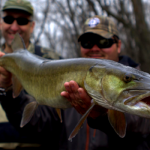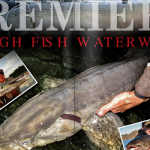Up here in the far North, when the water temperature begins to rise (55°F +), the days are growing in length (photoperiod) and the lunar phase gets right (full moon or new moon). Additionally, the lilacs have bloomed, the snapping turtles are laying eggs, and more importantly, bass are migrating into the shallows to spawn. Whichever variable or suite of variables you might use to indicate that bass are doing the “hippidy-dippidy”, cue the Barry White, because it will soon be time for a little afternoon delight.
For some, ethics comes into play, and it is a time to leave the bass alone for a while. For others it can be one of the most exciting times of the year to fish for trophy bass. Fishing becomes more like hunting, as you quietly stalk around in the shallows, and pass up smaller fish until you find a ‘shooter’. To quote Phil from the A&E Hit ‘Duck Dynasty’, you could slap me like a big ol’ bullfrog and say “Happy, Happy, Happy!”
I love to sight fish, and I’m also a Fisheries Biologist. Here is a little science behind the spawn. On a given lake approximately 33 % of the Bass population spawns, that means that there is 67 % of the bass population that does not contribute to recruitment in a given year. Next, some of the issues concerning bed fishing are the following: Nest predation; Fish Energetics; Water Temperature; Displacement of Fish; Hooking Mortality; Delayed Mortality; Best Practices with Catch and Release; and your provincial or state fishing regulations and season. One pet peeve of mine is a “higher than thou angler” saying he does not target spawning fish, then the next day I see him out there pounding the bank with a spinnerbait or topwater in the back of a pocket. Guess what, just because you can’t see the fish sitting on a bed, doesn’t mean you aren’t catching bed fish, it just means you’re oblivious. If you’re sitting out in 8-20 feet of water on a ledge catching pre-spawn fish now that’s a different story.
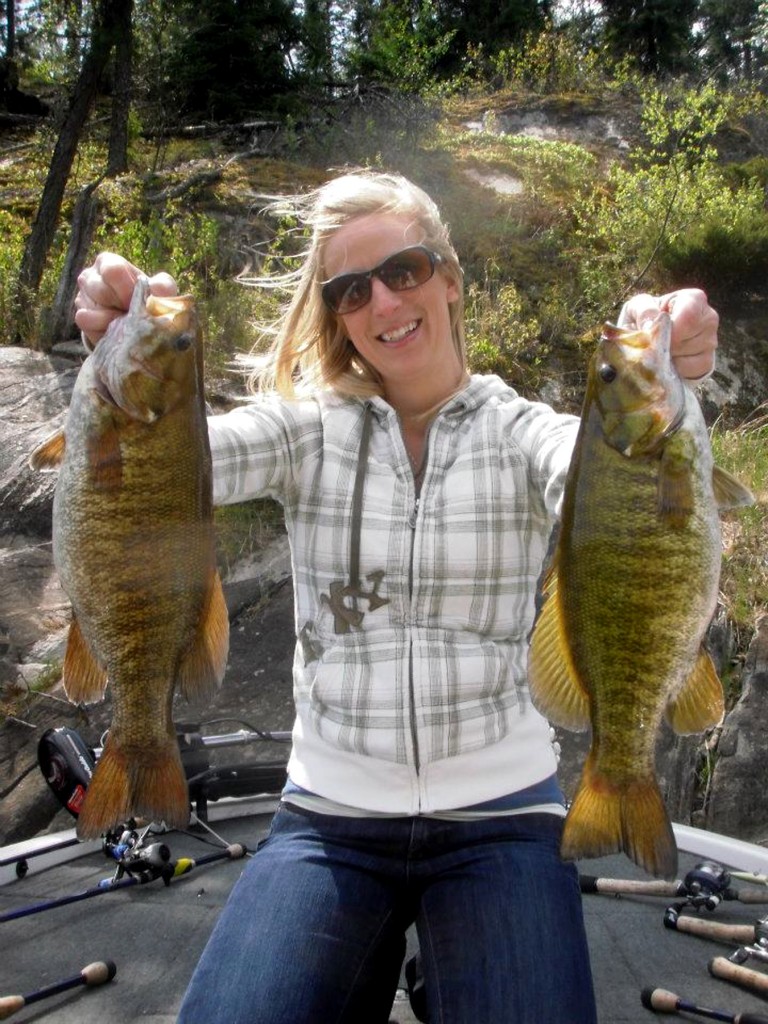
Scientific Facts
Nest Predation i.e.) Predators taking advantage of a bass that has been taken off its nest by consuming fry or eggs while the fish is being fought to the boat, handled, and released is indeed an issue. Especially on lakes with invasive species like round gobies, and rusty crayfish, this problem is maximized even more so. Quantifying this phenomenon is a different story. In fact, if proper catch and release is practiced, a fish removed from its nest for a minute or two may not suffer any predation of its nest. On the other hand, a lake infested with rusty crayfish may result in a different story and in turn, that nest could suffer a different fate.
Fish Energetics is another real issue at this time of year. The energy cost for a male bass to guard/defend its nest from predators is high. Consequently a fish that is angled off its nest is going to expend even more energy, include how long that fish is out of the water to remove hooks, factor in the air temperature, water temperature, hooking location, handling techniques, and you have a gamut of stressors for that fish. That being said, smallmouth and largemouth bass are hearty species, and if a fish is fought quickly, handled with care, and time out of the water is minimized, the energy expended may not be any more than the energy expended to defend its nest from a gang of yellow perch or crayfish.
Therein lays the rub. Personally, I believe that if a bass angler is savvy to the best practices of catch and release, the impacts of angling during the spawning period can be minimal. Tournaments during this time frame can be problematic, as the displacement of fish for extended periods, leaves the nest vulnerable to predators, and the energy costs for that bass to return to its nesting site will be unequivocally high. If he does make it back, chances are it’s too late, and if he makes it back in time, he might not have the energy left to defend his nest properly, and nest abandonment will then occur. That being said, some outstanding fisheries with high concentrations of bass will be able to withstand these rigors (remember approximately only 33 % of the population is spawning), and not all bass spawn at once. On top of that, recruitment is affected but that bass is still alive to spawn the following year. In some parts of Ontario, a catch and release season is open during the spawn, but you can’t possess large fish so there are no tournaments until July 1st. In southern parts of Ontario the season is completely closed. Different states and provinces have different regulations and seasons in place to effectively manage their fisheries. For the most part they are indeed effective at maintaining a sustainable fishery.
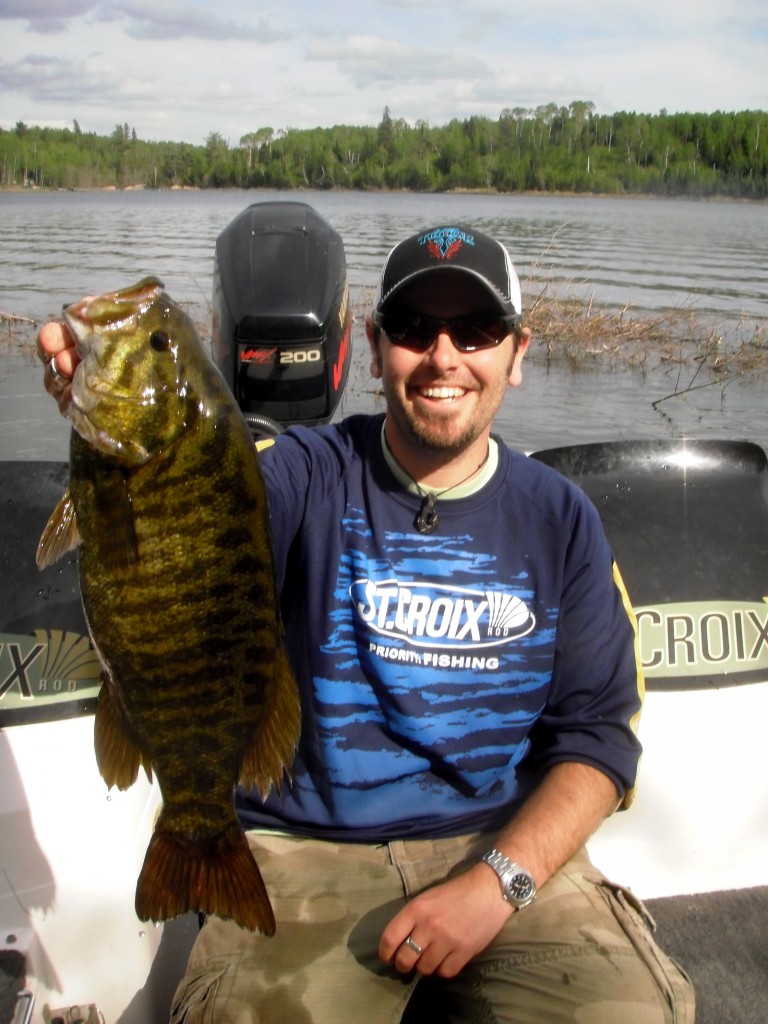
Sight Fishing Techniques
I think that’s enough Science for the day. Let’s get to the fun stuff. Sight Fishing / Bed Fishing requires a great deal of patience, and a well trained eye. Often times spotting the bed is more important than spotting the fish, initially anyways, especially when there are water clarity issues. I’ve found that most of the anglers that ask me about bed fishing or how to find beds are doing a couple of simple things wrong. First they don’t know what exactly they are looking for, and second they are too far away from the bank to see what they need to. A perfect day to learn how to bed fish is a day with bright bluebird skies, zero wind, fully charged trolling motor batteries, a hat, and a quality pair of polarized sunglasses.
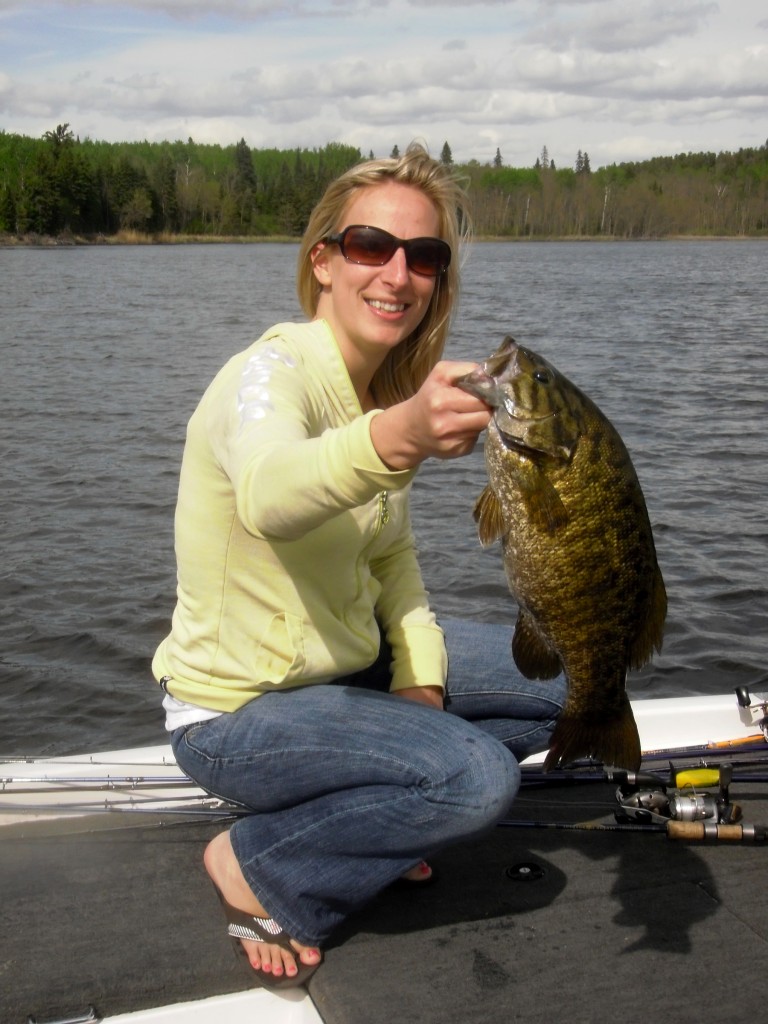 So you’ve located an ideal bank, and you’ve spotted a few beds… now what? Think of a bed like a bull’s-eye, this is where stealth and accuracy can be crucial. The vast majority of the time I use a St.Croix Legend Tournament ‘Plastics’ Rod (Model: TBS71MF) or a Legend Elite Spinning rod (Model: LES70MF), light line (6 # test), and I actually pitch underhand to my targets like you would with a flippin’ stick. I want a nice soft, accurate entry. Upon your first pitch, you will learn nearly everything you need to know about the bass in front of you. If he stays put, flares his gills, makes a sharp angry circle, or noses down on your bait, you’re in business! 9 times out of 10 if it’s a ‘fresh’ fish, he will nail it first cast…Oppositely, if he bolts immediately you’re in trouble, he’s either been caught before, you’re too close, you made a rough cast, he isn’t locked on yet, or it is late in the spawn. If the latter happens, here’s where the patience factor comes into play…
So you’ve located an ideal bank, and you’ve spotted a few beds… now what? Think of a bed like a bull’s-eye, this is where stealth and accuracy can be crucial. The vast majority of the time I use a St.Croix Legend Tournament ‘Plastics’ Rod (Model: TBS71MF) or a Legend Elite Spinning rod (Model: LES70MF), light line (6 # test), and I actually pitch underhand to my targets like you would with a flippin’ stick. I want a nice soft, accurate entry. Upon your first pitch, you will learn nearly everything you need to know about the bass in front of you. If he stays put, flares his gills, makes a sharp angry circle, or noses down on your bait, you’re in business! 9 times out of 10 if it’s a ‘fresh’ fish, he will nail it first cast…Oppositely, if he bolts immediately you’re in trouble, he’s either been caught before, you’re too close, you made a rough cast, he isn’t locked on yet, or it is late in the spawn. If the latter happens, here’s where the patience factor comes into play…
First, if the fish bolts, keep an eye on him, see how far he goes, and pay attention to how long it takes for him to come back. Often times a fish will have a defined territory, or route that it will take when disturbed, and may also have a place close by that it will sit and hide out (usually a big boulder, or piece of wood). Take a few visual markers, mark it with a waypoint, and make a wide outside turn and set up shop. I honestly feel that you can catch 98-100 % of bass that you see if you follow these steps carefully. First off, relax, be patient, and keep off the bed as far as possible, you want to be able to see the bed and hopefully the fish but not so close as to spook him. Next, let the fish settle down. One of the worst things you can do is make a whole bunch of noisy, sloppy casts before the fish is set back up. Keep boat noise to a minimum, walk lightly, don’t bang rod lockers, Plano trays etc, stay off the trolling motor as much as possible, keep it on low, shut all your electronics off, and even your live wells in extreme cases. Better yet, if you can, buy yourself a couple of Blade Series Power-Poles! I just bought mine for the 2012 season and they are flat out amazing! Just recently I was fishing late spawn conditions, only a few fish were left on beds, but they were big ones! I would have NEVER caught a couple of key fish that day without my Power-Poles. I sat on one fish in particular for close to 45 minutes. Conditions were tough, the wind was messing up my line of sight, and a bunch of clouds were making it tough to see. With my Power-Poles down, I was able to wait patiently in place, stay off the trolling motor, and stare up into the sky waiting for a group of clouds to pass, when the sun would peak out, I would pitch back in where I could see the fish, it would cloud up again and I would be sitting there blind waiting for the next window of light. Eventually, I boated that skittish bass and I wound up winning our club tournament for that week. I caught my three biggest fish that day off of beds with my Power-Poles down. Nobody else that week caught a bed fish! Power-Poles have so many applications beyond sight fishing (but we will leave that for another article).
Baits and Presentation
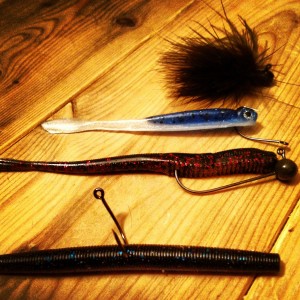 Let’s get to catching these spooky devils. First, this is the rare time of the year where you will find half a dozen spinning rods on my front deck. In fact the front deck of my Skeeter will often look like a war zone at the end of a good day of sight fishing. My top 4 choices for catching bedders are the following:
Let’s get to catching these spooky devils. First, this is the rare time of the year where you will find half a dozen spinning rods on my front deck. In fact the front deck of my Skeeter will often look like a war zone at the end of a good day of sight fishing. My top 4 choices for catching bedders are the following:
1. A wacky worm. My favorite are Venom Salty Slings, Wave Worm Tiki Sticks, or the Yamamoto senko, rigged with a Lazer Trokar TK120 4/0 Magworm Hook. Don’t get too hung up on color, I usually have a natural colored one, and a god-awful bright one. These baits are best rigged weightless, that slow shimmying fall gets them more often than not. If they ignore that, I like to have a smaller 3 or 4 inch finesse version to follow up from the standard size.
2. The drop shot. I like about a 10-14 inch leader with a Venom Dropshot Minnow, or a Waveworms tikidrop, rigged with a Lazer Trokar TK150 Dropshot Hook. The St.Croix Legend Tournament Dropshot/Finesse Spinning rod (Model: TBS610MLXF) is ideal for this technique as the soft tip allows you to shake the bait in place, and the medium light power keeps that small Lazer Trokar hook were it should be, and absorbs those powerful boat-side surges that big smallmouth are notorious for. The best part about this technique is that you can virtually keep the bait suspended in the bed indefinitely, and sit there and shake the bait until the bass finally gives in. This method has caught me more skittish bass than any other tactic, and catches them when they ignore everything else! The take is almost always subtle, most of the time you’re better off just to line watch, as they tend to inhale it and just gently swim off.
3. The shakey head. I like a 1/8 oz screw lock version jig head with a straight shank 4’0 hook, 90 degree line tie; I pair this with a Venom Due Drop Worm, or a Reaction Innovations Flirt Worm 4.95. My favorite colors are green pumpkin and red flake, and a natural smoke color. This is probably my favorite bed bait because you can fish it fast, shake it in place, and it’s heavy enough to sink quickly. Bass seem to hit the shakey head a lot harder than any of the other baits I use, it seems to make them mad, and I like that!
4. Black hand-tied marabou hair jig. A lot of my Canadian tournament buddies will be angry at me for mentioning this, although the proverbial cat has been out of the bag now for a few years. In fact many Canadian anglers were going down to the northern United States for tournaments that coincided with the spawn, and they were flat out smoking the field. This bait falls ultra slow, breathes and undulates in the water, and best mimics a small leach or bug. This thing catches some of the most negative fish out there, and the applications are endless with smallmouth. Most of my tournament buddies hand-tie their own. I get my good buddy Ron Achilles from Rockpile Lures to tie them for me. He uses a small 1/16 oz head with a tiny 1/0 Venom Black Nickel 90 degree jig hook, black thread, and black marabou.
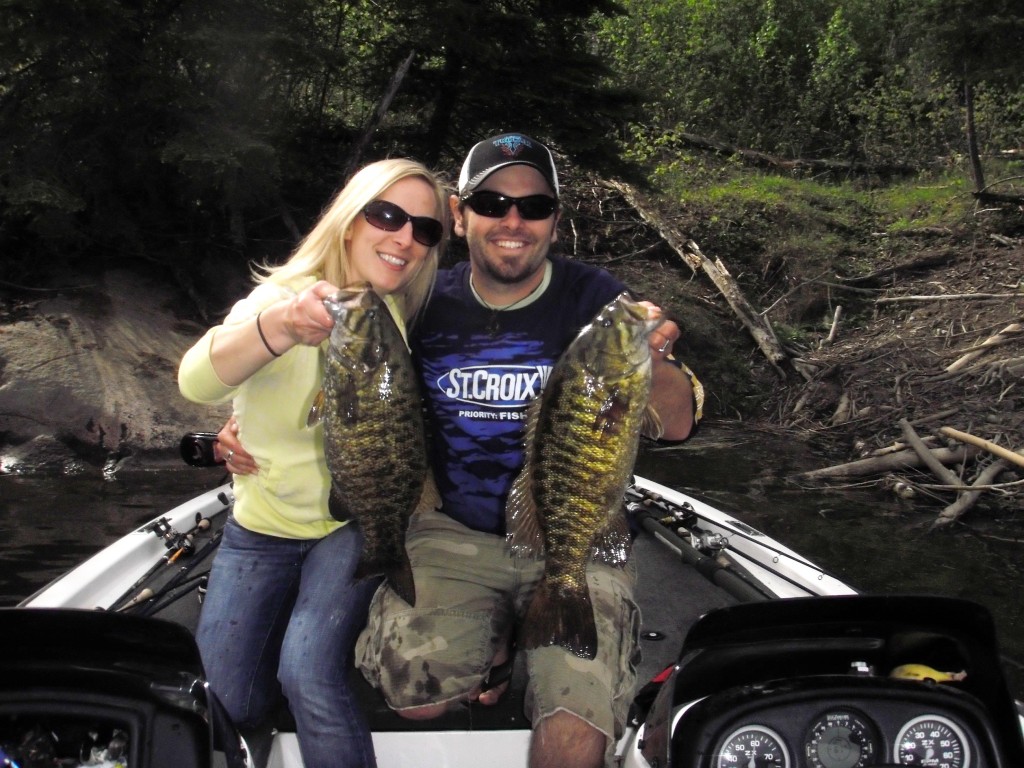
In conclusion, start with the shakey head or senko. If those don’t work, switch it up to a drop shot rig. Then if that doesn’t work throw in the hair. Maybe next time you should take a better look, because chances are you’ve been staring at a rock, shadow, piece of wood, or your flat out hallucinating! I know there have been many nights after long sight fishing tournament days where I’ve closed my eyes and all I can see are bass beds everywhere. My girlfriend has elbowed me for talking in my sleep, whispering, “That’s a good one”, “There’s a Bed!”, or “Don’t move!”
Josh Peacock, 28, fisheries biologist, is a successful tournament angler with several top-ten finishes from Northwest Ontario. The Kenora area of Lake of the Woods is his home and he is taking his bass fishing talents to the FLW tour as co-angler in 2013.



